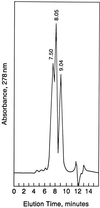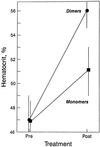Human erythropoietin dimers with markedly enhanced in vivo activity
- PMID: 9448306
- PMCID: PMC18713
- DOI: 10.1073/pnas.95.3.1184
Human erythropoietin dimers with markedly enhanced in vivo activity
Abstract
Human erythropoietin, a widely used and important therapeutic glycoprotein, has a relatively short plasma half-life due to clearance by glomerular filtration as well as by other mechanisms. We hypothesized that an erythropoietin species with a larger molecular size would exhibit an increased plasma half-life and, potentially, an enhanced biological activity. We now report the production of biologically active erythropoietin dimers and trimers by chemical crosslinking of the conventional monomeric form. We imparted free sulfhydryl residues to a pool of erythropoietin monomer by chemical modification. A second pool was reacted with another modifying reagent to yield monomer with maleimido groups. Upon mixing these two pools, covalently linked dimers and trimers were formed that were biologically active in vitro. The plasma half-life of erythropoietin dimers in rabbits was >24 h compared with 4 h for the monomers. Importantly, erythropoietin dimers were biologically active in vivo as shown by their ability to increase the hematocrits of mice when injected subcutaneously. In addition, the dimers exhibited >26-fold higher activity in vivo than did the monomers and were very effective after only one dose. Dimeric and other oligomeric forms of Epo may have an important role in therapy.
Figures







Similar articles
-
Development of a long-acting erythropoietin by fusing the carboxyl-terminal peptide of human chorionic gonadotropin beta-subunit to the coding sequence of human erythropoietin.Endocrinology. 2007 Oct;148(10):5081-7. doi: 10.1210/en.2007-0026. Epub 2007 Jul 19. Endocrinology. 2007. PMID: 17641000
-
Depression of stimulated erythropoietin production in mice with enhanced erythropoiesis.Haematologica. 1995 Nov-Dec;80(6):491-4. Haematologica. 1995. PMID: 8647512
-
Evaluation of bioactivity and pharmacokinetic characteristics of PEGylated P.pastoris-expressed erythropoietin.Drug Deliv. 2011 Nov;18(8):570-7. doi: 10.3109/10717544.2011.600782. Epub 2011 Sep 5. Drug Deliv. 2011. PMID: 21892875
-
Clinical pharmacokinetics of epoetin (recombinant human erythropoietin).Clin Pharmacokinet. 1991 Feb;20(2):99-113. doi: 10.2165/00003088-199120020-00002. Clin Pharmacokinet. 1991. PMID: 2029809 Review.
-
The human erythropoietin receptor.Int J Cell Cloning. 1992 Sep;10(5):254-61. doi: 10.1002/stem.5530100502. Int J Cell Cloning. 1992. PMID: 1453011 Review.
Cited by
-
The Influence of Dimerization on the Pharmacokinetics and Activity of an Antibacterial Enzyme Lysostaphin.Molecules. 2019 May 16;24(10):1879. doi: 10.3390/molecules24101879. Molecules. 2019. PMID: 31100806 Free PMC article.
-
Innovative Metrics for Reporting and Comparing the Glycan Structural Profile in Biotherapeutics.Molecules. 2023 Apr 7;28(8):3304. doi: 10.3390/molecules28083304. Molecules. 2023. PMID: 37110538 Free PMC article.
-
CNTO 530 functions as a potent EPO mimetic via unique sustained effects on bone marrow proerythroblast pools.Blood. 2009 May 14;113(20):4955-62. doi: 10.1182/blood-2008-08-172320. Epub 2009 Mar 5. Blood. 2009. PMID: 19264917 Free PMC article.
-
Molecular Design, Expression and Evaluation of PASylated Human Recombinant Erythropoietin with Enhanced Functional Properties.Protein J. 2017 Feb;36(1):36-48. doi: 10.1007/s10930-017-9699-9. Protein J. 2017. PMID: 28168382
-
Pharmacokinetics and pharmacodynamics of recombinant human EPO-Fc fusion protein in vivo.PLoS One. 2013 Aug 19;8(8):e72673. doi: 10.1371/journal.pone.0072673. eCollection 2013. PLoS One. 2013. PMID: 23977338 Free PMC article.
References
Publication types
MeSH terms
Substances
Grants and funding
LinkOut - more resources
Full Text Sources
Other Literature Sources
Research Materials

